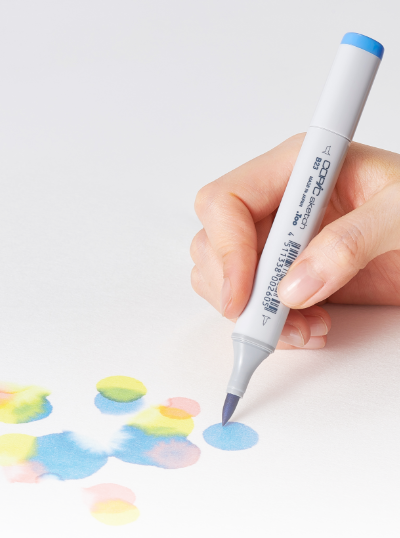The “Other” Color Families
15-04-2024
Earth-tones, Grays, Achromatic & Fluorescents

Howdy Copic readers! In our previous blog, we discussed cool versus warm colors and how Copic markers fit into those groups. We also shared a “Creating a Copic Color Palette” exercise, where you can download and test out your own marker palettes with a sample line illustration (found in our line art gallery here). Today, we’ll be taking a look at the “other” Copic colors that aren’t found on a standard color wheel; specifically, the Earth-tones, Grays, Achromatics, and Fluorescents. With that being said, let’s get started by taking a look at the image below!

The Copic Color Swatch Cards are displayed here by how they fall into their respective color groups, but with achromatic and fluorescent colors on the same card (since they are both very small groups). Interestingly enough, there are almost as many earth-tone colors as there are grays, and together, they make up 99 of the total 358 Copic colors. That’s a significant portion of the entire Copic color range! 
In the image/chart above, all 358 Copic colors are displayed by using the Copic Color Swatch Cards and categorizing them into their respective groups. There are 145 cool colors, 104 warm, 53 earth-tones, 46 grays, 3 achromatic, and 8 fluorescent.
There are also a few Copic Stats listed on the side of this graphic, and those stats point out the number of colors that fit into the 3 Copic marker types. The Ciao marker contains 180 of these colors, Copic Classic contains 214, and Copic Sketch contains all 358. Another important stat to point out is that EVERY COPIC MARKER can be refilled with Copic Ink, and Copic Ink comes in all 358 colors.
For over 3.5 decades (the first Copic marker made its debut in 1987), Copic has been producing color-consistent, high-quality markers, meaning that if you bought a B00 marker in 2004 and it dried up, you can purchase a bottle of Copic Ink B00 and use it to revive the dried up marker. That’s how high-quality and color-consistent Copic colors have been and still are today!


Now that all 358 colors - along with a brief history of the Copic brand - have been introduced, let’s discuss how you can use the truly “other” colors: achromatic and fluorescents. There are only 3 achromatic colors: 0 Colorless Blender, 100 Black, and 110 Special Black. However, these 3 colors are statistically some of the most-purchased colors. Why? Because they’re extremely versatile! There are so many tips and tricks that can be used with the 0 Colorless Blender (see the above template), and how can a marker collection be complete without at least one shade of black?
The reason these 3 colors are called “achromatic” is because they either lack all of the colors (white, or in Copic terms, the 0 Colorless Blender) or include all of them (black, or in Copic terms, 100 Black or 110 Special Black). These colors, much like earth-tones and grays, do not fit on the standard color wheel. They are outliers, but as any artist can attest, are extremely important to any artist’s toolkit.


The next “other” color group is arguably the most “other” of them all: the Copic fluorescents. There are only 8 of these colors, split evenly with 4 warm and 4 cool, but they’re all extremely bright to live up to their name of being fluorescent. Unlike the achromatic colors, these markers are among the least-purchased. Why is that? Maybe that is because they don’t blend together the same way as the other 350 colors, they don’t scan into a computer with the same level of color accuracy, and not many artists work with such bright and saturated colors on a regular basis. In fact, what images come to mind that would warrant the use of fluorescent colors?
The template above explores some of the most common uses for the fluorescent marker group, namely, with the example of flowers, plants, and animals in a tropical rainforest environment. There are definitely other subjects that can be colored with fluorescent colors - a simple doodle can be colored with fluorescents! However, we recommend that if you’re interested in these 8 “other” Copic marker colors, download the template above and give it a try at home!

And with that, we wrap up today’s blog! Stay tuned for next month, where we’ll go into detail on the 4 different types of Copic gray!
Until then, don’t forget to follow us across our social media channels @copic_official_us, and sign up for exclusive discounts and prizes by joining the Copic Club! One last thing - use #copicwithus or tag us @copic_official_us for a chance to have your drawings featured on our Copic US social media channels and the homepage on our website!
Thank you so much for reading and enjoying Copic markers as much as we do! 😀
Read More Articles
The Best Papers for COPIC Acrea
How to Layer with Acrea on Various Types of Paper Hello Copic readers! In our previous blog, we wrapped up our discussion on how to use ...

Copic Acrea with Copic Ink
How can Acrea be used with Copic Ink? Greetings Copic readers! In our previous blog, we discussed how Acrea compares with Copic Multil...

Copic Acrea with Multiliners
How does Acrea compare with Copic Multiliner Pens? Greetings Copic readers! In our previous blog, we discussed how Acrea compares to the ...

Copic Acrea with Copic Markers
How does Acrea compare with Copic Markers? Hello Copic readers! In our previous blog, we introduced the NEW Copic product; the Acrea pa...





